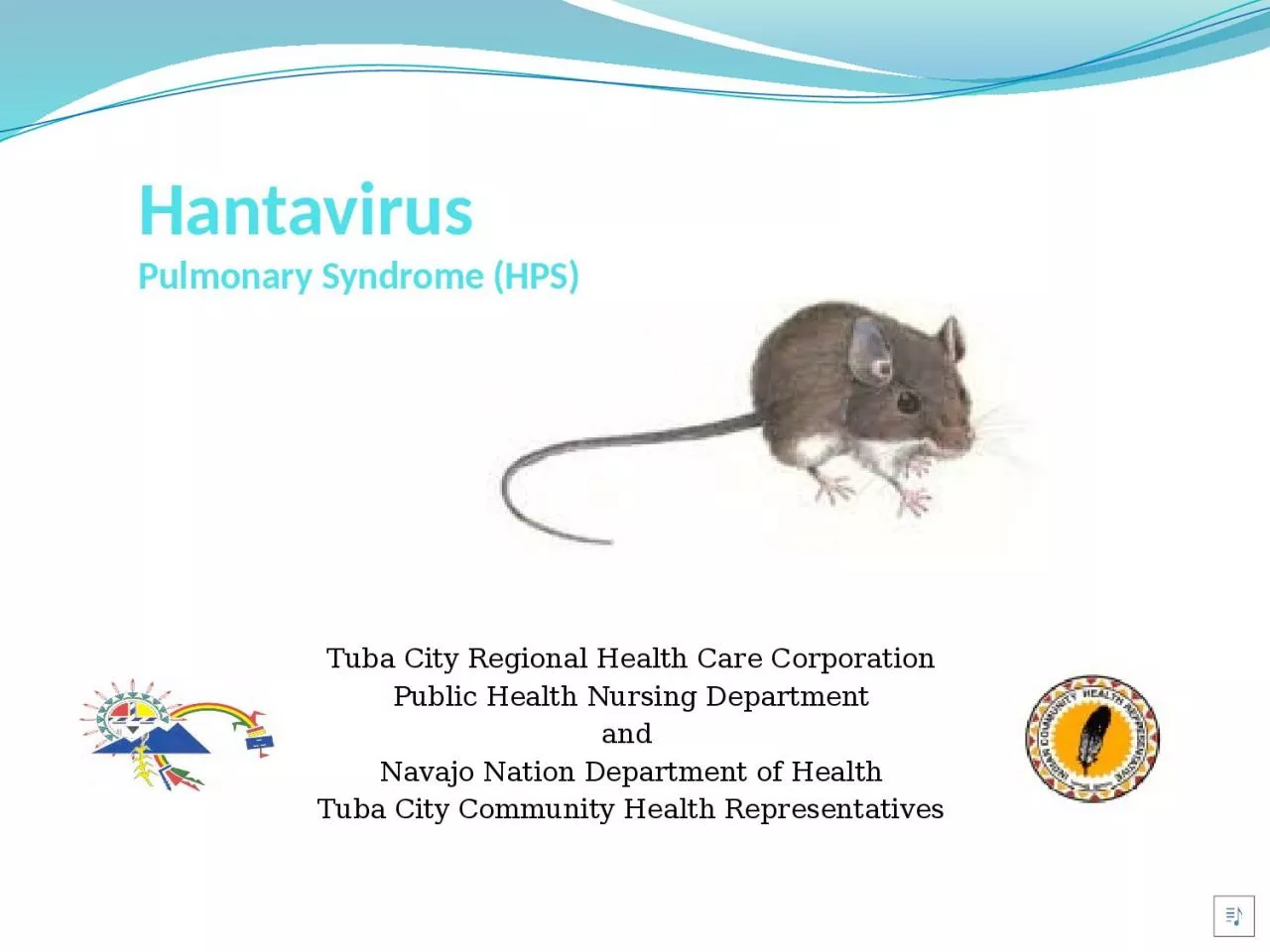

Tuba City Regional Health Care Corporation Public Health Nursing Department and Navajo Nation Department of Health Tuba City Community Health Representatives Hantavirus Definition Hantavirus Pulmonary Syndrome HPS is a rare but serious sometimes deadly respiratory disease in humans caused ID: 927159
Download Presentation The PPT/PDF document "Hantavirus Pulmonary Syndrome (HPS)" is the property of its rightful owner. Permission is granted to download and print the materials on this web site for personal, non-commercial use only, and to display it on your personal computer provided you do not modify the materials and that you retain all copyright notices contained in the materials. By downloading content from our website, you accept the terms of this agreement.
Slide1
HantavirusPulmonary Syndrome (HPS)
Tuba City Regional Health Care CorporationPublic Health Nursing Departmentand Navajo Nation Department of HealthTuba City Community Health Representatives
Slide2Hantavirus Definition
Hantavirus Pulmonary Syndrome (HPS) is a rare but serious, sometimes deadly, respiratory disease in humans caused by infection with hantavirus.The hantavirus is carried in the urine, saliva or feces of infected rodents such as rats, squirrels, chipmunks, and other types of mice.
Slide3History
Hantavirus is named for the Hantan River area in South Korea where an early outbreak occurred in the 1970’s.Hantavirus has been documented in 34 of the 50 states in the United States. In 1993, hantavirus was seen in the Four Corner’s Area on the Navajo reservation.
Slide4Who is at Risk?
Person living, visiting, or working in places with rodents infestations.People who have moved into empty homes where rodents may have been.Individuals who enter or clean outdoor buildings, storage sheds or shacks where rodents are likely to live.
Slide5Hantavirus Exposure:
Breathing in the virus. This may happen when rodent urine and droppings containing the hantavirus are stirred up into the air.Touching eyes, nose or mouth after touching rodent droppings, urine of nesting material containing the virus.A bite from an infected rodent.
Slide6Signs and Symptoms
Early Symptoms:Fevers (101° – 104° F)Headaches or dizzinessChills
Muscle AchesStomach Aches or painWeakness
If any of these symptoms appear, seek medical attention immediately.Late Symptoms:
Shortness of breathDifficulty breathingAfter exposure to hantavirus, a person can get sick between 7 days and 3 weeks after getting the virus.
Slide7Prevention
Eliminate or minimize contact with rodents in your home, work place, outdoors sheds or campsite.There’s an easy way to do this: Seal up! Trap up! Clean up!
Seal up holes inside and outside the home to keep rodents out.
Trap rodents around the home to help reduce the population.
Keep your home clean. Clean up any food that is easy to get to.
Slide8Here’s what YOU can do:
Keep your home clean. Wash dishes and clean up after meals.
Dispose of garbage in trash cans with tight-fitting lids.
Get rid of indoor and outdoor junk and clutter.
Keep woodpiles or hay bales as far away as possible from your home.
Do not leave pet food out.
Slide9Cleaning Recommendations
If you find dead rodents, rodent nests, food piles, or rodent droppings or urine do not sweep or use vacuum cleaners, instead do the following:
Open doors and windows of the building for at least 1 hour before cleaning.
Gather the following items to clean:
Slide10Cleaning Recommendations
Prepare cleaning disinfectant mixture:3. Pour 1 and a half cups of liquid bleach and add it to 1 gallon of water in a bucket. Then pour into a spray bottle.
4. Before cleaning, if you have a mask, put on the mask to cover your nose and mouth.
Using the disinfectant mixture, thoroughly spray dead rodents, droppings, rodent nests, or rodent food piles and soak for 15 minutes. Spray surrounding area with flea spray BEFORE starting clean up.
Slide11Cleaning Recommendations
5. After disinfecting wear rubber gloves to clean up the droppings with disposable materials, such as paper towels or rags.6. Seal all materials, droppings or nests in double plastic bags , then burn and bury it deep in the ground, so that pets won’t dig it up.7. If you use reusable gloves, wash them with your bleach mixture and use soap and water. Also, disinfect and allow to air dry any tools or utensils that you have used.
Slide12Frequently Asked Questions
When do hantavirus cases occur? During all months of the year, but the greatest number of cases has been documented in the spring and summer months. There is evidence that periods of high rain and snowfall have more cases.
Slide13Frequently Asked Questions
Can hantavirus be transferred from person to person?
There have been no cases in which a person got the infection from another person.
-You cannot get the virus from touching or kissing a person
-You cannot get the virus through transferring of blood
Slide14Frequently Asked Questions
Can pets transfer the hantavirus to humans? Hantavirus is not known to be carried by any other types of animals except for certain rodents. Dogs and cats are not known to carry hantavirus; however may bring an infected rodent into contact with people if they catch and carry them into a home.
Slide15Questions
For More Information Contact:Angie Maloney or Lyndon EndischeeEnvironmental Health Services928-283- 2844